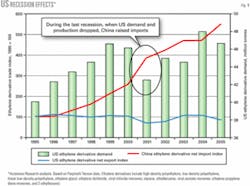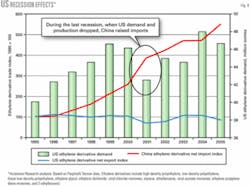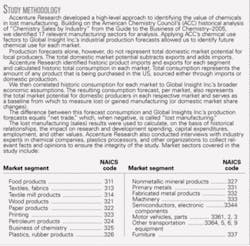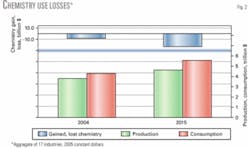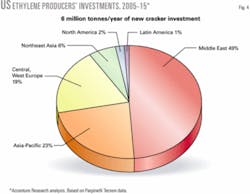The US petrochemical business is experiencing a lower level of growth due to lost manufacturing or “deindustrialization” trends. This situation is more prevalent during each down cycle, when downstream manufacturing moves into other countries even faster. Less demand causes lower profits and, in turn, the shutting down of finished-goods plants in the US.
Suppliers in lower-cost regions pick up the slack and expand production volumes. For instance, in the last worldwide olefins down cycle, whose low point occurred in 2001, domestic demand and exports for ethylene derivatives declined by about 8% and 33%, respectively. At the same time, China increased its imports of the same derivatives by 50%, as it gained market share in the downstream finished goods market using those materials (Fig. 1).
At that time, petrochemical producers took various reactive measures, such as shutting down high-cost plants. US producers must anticipate the next step change in lost manufacturing and proactively improve their businesses, as well as support legislation that favors free and competitive markets (especially for energy development).
These are some of the conclusions of a study conducted by Accenture Research for the American Chemistry Council (ACC), entitled “Lost US manufacturing-the impact on the business of chemistry” (www.americanchemistry.com/store).
Study overview
Our study for the ACC quantified the impact of lost downstream manufacturing (of 17 selected industries) on the future chemical industry. The study concluded that domestic demand for manufactured goods will outpace domestic industrial production; imports will fill this gap.
See the attached box for the study’s methodology.
Although domestic production of finished goods will still increase, imports will rise faster. This implies that US manufacturers will lose market share and, therefore, chemicals manufacturers will lose the demand for chemicals associated with manufacturing these products (Fig. 2).
Total chemical sales-opportunity losses represent just 2.4% of the expected $8 trillion total manufacturing industry sales-opportunity losses (or cumulative net trade losses by 2015) caused by lost manufacturing.
Estimated cumulative opportunity losses (based on trade losses) during the next 10 years include:
- $188 billion in chemical sales, including $50 billion in sales from the top seven thermoplastic resins.
- $40 billion in capital expenditures in chemicals, including $5.5 billion for new thermoplastics capacity.
- $30 billion in chemical research and development expenditures.
- $43 billion in US government tax revenue from chemical companies.
- $3 billion in charitable contributions from chemical companies.
- 157,000 chemical industry related jobs.
Chemicals are on the front line of lost manufacturing in the US. Coupled with relatively higher production costs in the US, the movement out of the US for industries that consume industrial chemicals is causing a shift in chemicals investment focus overseas. The growth of overseas manufacturing in northern Asia, China in particular, has a cascade effect on those industries supplying industrial users, especially raw material manufacturers.
As a large supplier to other industries, the petrochemicals industry is one of the businesses most seriously affected by this trend.
Besides relatively higher labor and regulatory costs in the US, high energy prices are contributing to the decline of US industrial production. High and volatile US natural gas prices and unreliable supplies affect electricity costs and, in the case of chemicals, raw material costs as well (Fig. 3).
Volatility also causes uncertainty in production planning and volume expansion. Energy is the largest input factor for most base chemicals; therefore, reliable, low-cost energy supplies are critical to ensuring chemical industry competitiveness.
Chemicals and energy represent 10% of the costs of the 17 industries analyzed in this study (Table 1). Because these industries have total revenues of nearly $4 trillion, it is imperative that the US chemical industry remains viable. Making hydrocarbons available at competitive prices and encouraging legislation that favors domestic chemicals investment would go a long way to ensuring the industry’s future.
Olefins end markets
The lost-manufacturing study determined that by 2015, about 11 million tonnes of the top seven thermoplastics will be imported instead of produced domestically (Table 2). The associated losses in new thermoplastic resin plant investments are about $5.5 billion. Thermoplastics consumed in industries that are easily moved “offshore” (such as consumer products or furniture production) will suffer the most.
The study also concluded (based on Accenture Research discussions with plastics processors accounting for up to $3.5 billion in sales) that, although lower labor costs in other regions have drawn labor-intensive manufacturing away from the US, the downstream industry has been engaged in development of highly innovative and leading practices, resulting in new products, process improvements, and supply chain enhancements just to stay in business.
They are working against increasing cost pressures in transportation and plant direct costs, many of which are related to rising energy prices. This may dampen the competitive edge they have achieved through technological innovation. For steam cracker operators, this means eventual erosion of downstream markets for derivatives.
Olefins production effects
Some 65% of US ethylene production capacity is based on natural gas feed. Most European and Asian ethylene production, in contrast, is based on liquids that are related to oil prices. The correlation of gas prices to oil prices, therefore, directly affects US ethylene operating rates and profitability.
Relatively higher gas prices can reduce the competitiveness of US ethylene production (in aggregate, because some plants are liquids-based or have some feed flexibility). A low, steady gas-to-oil price ratio is critical to maintaining the US competitive position in ethylene and its related derivatives and coproducts or by-products.
To date, no greenfield ethylene (the most important base organic chemical) plants are scheduled for completion in the continental US. US domestic producers are reluctant to invest because of uncertainty surrounding environmental legislation and energy policy. Instead, US-based ethylene producers have announced construction plans for about 6 million tonnes of new ethylene capacity investment (equivalent to about $15 billion) during the next 10 years in other regions (Fig. 4).
This lack of cracker investment in the US has implications not only for the obvious commodity derivatives, but also for a large number of downstream industries that depend on various cracker coproducts and by-products, including those in specialty markets with few alternative sources of supply.
Strategic alternatives
US olefins producers must act now, during this period of high margins, to prepare for a period of strong competition in “traditional” downstream markets. Although foreign investment is still essential for global players, petrochemical companies should carefully consider realigning their US assets, which have a total current replacement value of about $65 billion (steam cracking alone), instead of targeting 100% of expansion funds overseas
Portfolio and business structure re-alignment may be necessary for these assets to compete in the future. Producers must determine which markets have the most growth potential and then develop plans to re-align their derivative businesses to best serve those customers.
The lost manufacturing study determined that large-end market industrial sectors are still growing in the US. To serve these growing markets in the long term, chemical companies must innovate in the supply chain, in manufacturing operations, and in the end products themselves. The appropriate changes will depend on each company’s business model and market drivers.
Some strategies may include:
- Focusing product portfolio to end markets with the best prospects (based on the company’s current position).
- Differentiating derivatives to meet developing needs of the highest potential growth segments.
- Searching for service value opportunities in customer industries.
The precepts of any strategy must aim to develop close, selective customer collaboration, where the producer joins with the customer to compete for the future of the market segment. There must be a strategic shift from the traditional “cost plus” model towards “output value” model, which requires a deep understanding of a customer’s value chain and its value extraction.
Some tools rising in importance in this respect are in the areas of customer relationship management and research and development (such as high-throughput chemistry). Outsourcing various back-office processes or developing other business process efficiencies can enhance domestic competitiveness.
The author
Paul Bjacek (paul.bjacek @accenture.com) is the global chemicals-natural resources strategic research lead for Accenture, Houston. He has 20 years’ experience in the chemicals industry, 7 of which were with Chevron Chemical Co. Bjacek is currently engaged in assessing high-performance businesses and practices in the chemicals industry. He hold and MS from the London School of Economics and a BS in chemistry and business from the University of Scranton, Pa. He is past president of the Commercial Development & Marketing Association.
